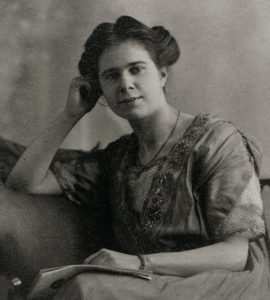Established in 1922 as the Museum of Greek Archaeology, the Ure Museum has grown from a small collection of gifts, bequests, and personal donations to the fourth largest collection of Greek ceramics in Britain. Its founders, the classical archaeologists Percy Neville Ure and Annie Dunman (Hunt) Ure, worked tirelessly to assemble the core of this significant collection.
The Museum of Greek Archaeology evolved out of University College Reading’s “nucleus of an archaeological collection”—the Egyptian, Cypriot, Greek and British antiquities displayed in the College Library during the First World War. In 1919, a Museum of Archaeology and History housing these artefacts was opened at Number 30 Portland Place on the College’s campus in London Road. Three years later, a new Museum of Greek Archaeology was established at Number 28 and the Egyptian, Cypriot and Greek antiquities were moved there. Percy and Annie Ure further developed the Museum through purchases, donations and bequests over the course of the next fifty years, supported by grants from the College and the University Friends. Annie Ure served as the Museum’s Honorary Curator, alongside publishing her own research on ancient Greek pottery. Key acquisitions made during this period include
- A 12th Dynasty model boat from Beni Hasan, Egypt (E.23.3) and other Egyptian antiquities purchased from the University of Liverpool
- Attic and Boeotian pottery from the Lake Copais region (26.12.1-34, 29.11.1-13, 34.10.1-27), from the collection of Julia Katharine Steele and her sister Anne Mary Wickes
- A large Attic black-figure hydria (28.9.1) showing a hunting scene purchased with a grant from the Friends of the University
- An Etruscan black figure amphora (47.6.1) featuring the Trojan prince Troilos, attributed to the Tityos Painter
- A Corinthian “Sam Wide” cup (47.8.1), given by local resident John Fothergill, author of An Innkeeper’s Diary
- An Attic red-figure oinochoe (51.7.1), the name vase of the Hasselmann Painter
- A Euboean black figure lekanis (56.8.8), purchased with a grant from the Friends of the University
In addition to these acquisitions, in the 1950s Reading Museum loaned a significant collection of 300 vases to the Museum of Greek Archaeology. The Museum moved from its original home on London Road to a new display space in 1957, when the University opened its Whiteknights Campus.
On Annie Ure’s death in 1976, Professor Jane Gardner became the Museum’s curator, assisted by Brian Sparkes. In 1984 the museum was renamed the Ure Museum after its founders. When Professor Gardner retired in 1999, the post of Curator was then taken by Dr Peter Stewart. Professor Amy Smith has served as the Curator since 2000, co-created the Ure Database with Brian Fuchs in 2002, and in 2005 led the redisplay of the Museum.
As one of the oldest museum collections in the University of Reading, the Ure Museum’s archive holds important records relating to the history of the College in the early 20th century. It also reflects Percy and Annie Ure’s work on the archaeology of Greece, visible in the records of their excavations at Rhitsona and in their correspondence over the course of their professional lives.

